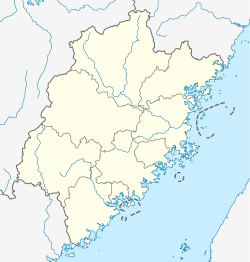Qiaodou Village
Qiaodou
桥兜村 | |
|---|---|
Village | |
 Qiaodou Location in Fujian | |
| Coordinates: 25°18′26″N 119°12′15″E / 25.30722°N 119.20417°ECoordinates: 25°18′26″N 119°12′15″E / 25.30722°N 119.20417°E | |
| Country | PRC |
| Province | Fujian |
| City (Prefecture) | Putian |
| District (County) | Licheng |
| Town | Huangshi |
| Population (2010) | 1,000 |
| Time zone | UTC+8 (China Standard) |
| Qiaodou | |||||||
|---|---|---|---|---|---|---|---|
| Traditional Chinese | 橋兜 | ||||||
| Simplified Chinese | 桥兜 | ||||||
| |||||||
| Former names | |||||||
|---|---|---|---|---|---|---|---|
| Ninghai | |||||||
| Traditional Chinese | 寧海 | ||||||
| Simplified Chinese | 宁海 | ||||||
| Literal meaning | Pacifying the Sea(s) Pacified Sea(s) | ||||||
| |||||||
Qiaodou Village is a village under the administration of Huangshi in Putian's Licheng District on the central coast of Fujian Province, China.[1][2] It had about 1,000 people during the 2010 census.
Geography[]
Qiaodou lies on the southern Putian Plain northwest of the Houhai bay or lake.
History[]
Qiaodou was known as Ninghai during the Song and Ming.[3] It is still home to the ancient stone Ninghai Bridge over a branch of the Mulan.[4]
Religion[]
Qiaodou is the site of the earliest-attested temple to the Chinese sea goddess Mazu, the deified form of the 10th-century shamaness Lin Moniang.[5] Supposedly, Lin was born on nearby Meizhou Island, usually regarded as the cradle of her cult, but she probably spent her adult life on the mainland.[6] In 1086, she joined the deities venerated at the town's "Holy Mound" (圣墩, Shengdun) after appearing to the villagers in their dreams following a series of mysterious lights at the mound.[7]
The main temple in the Qiaodou area today is the (纠察庙) honoring the Great God of Jiucha (纠察大神). Its religious processions occur on the second and third days of the second lunar month.[3]
References[]
Citations[]
- ^ 2018年统计用区划代码和城乡划分代码:黄石镇 [2018 Statistical Area Numbers and Rural-Urban Area Numbers: Huangshi Town] (in Chinese). National Bureau of Statistics of the People's Republic of China. 2018. Retrieved 2019-03-24.
350304101229 112 桥兜村委会
- ^ 黄石镇 [Huangshi Town] (in Chinese). XZQH.org. 2015-07-11. Retrieved 2019-03-24.
辖{...}桥兜、{...}36个行政村{...}【2013年代码及城乡分类】350304101:{...}~229 112桥兜村
- ^ a b Dean & al (2010), p. 226.
- ^ Luo & al. (1993).
- ^ Clark (2007), p. 203.
- ^ Clark (2006), p. 224.
- ^ Soo (1990), p. 31.
Bibliography[]
- Clark, Hugh (2006), "The Religious Culture of Southern Fujian, 750–1450: Preliminary Reflections on Contacts across a Maritime Frontier" (PDF), Asia Major, Vol. XIX, Pt. 1, Taipei: Institute of History and Philology.
- Clark, Hugh R. (2007), Portrait of a Community: Society, Culture, and the Structures of Kinship in the Mulan River Valley (Fujian) from the Late Tang through the Song, Hong Kong: Chinese University Press.
- Dean, Kenneth; et al. (2010), Ritual Alliances of the Putian Plain, Vol. II, Handbook of Oriental Studies, §4: China, Vol. 23/2, Leiden: Brill.
- Luo Zhewen; et al. (1993), Ancient Chinese Bridges.
- Soo Khin Wah (1990), "The Cult of Mazu in Peninsular Malaysia", The Preservation and Adaption of Tradition: Studies of Chinese Religious Expression in Southeast Asia, Contributions to Southeast Asian Ethnography, No. 9, Columbus: OSU Department of Anthropology, pp. 29–51.
- Fujian geography stubs
- Populated places in Fujian
- Temples of Mazu
- Villages in China